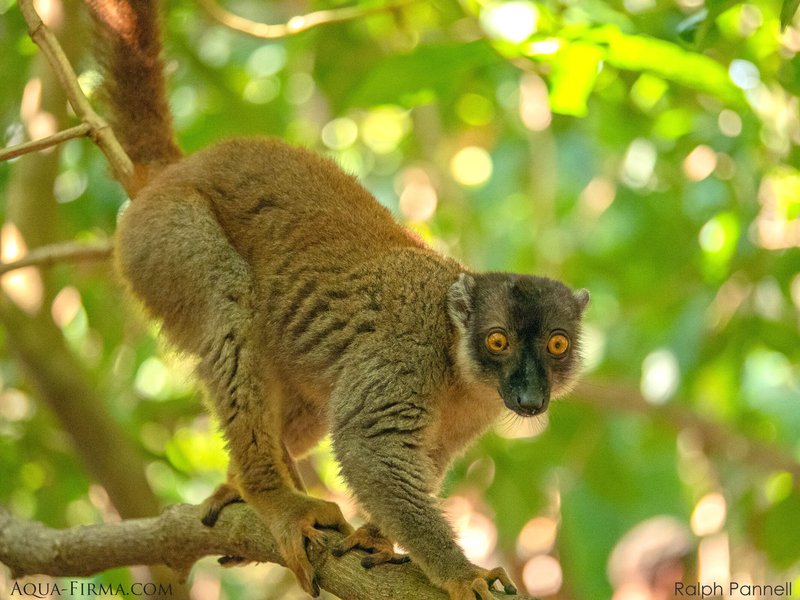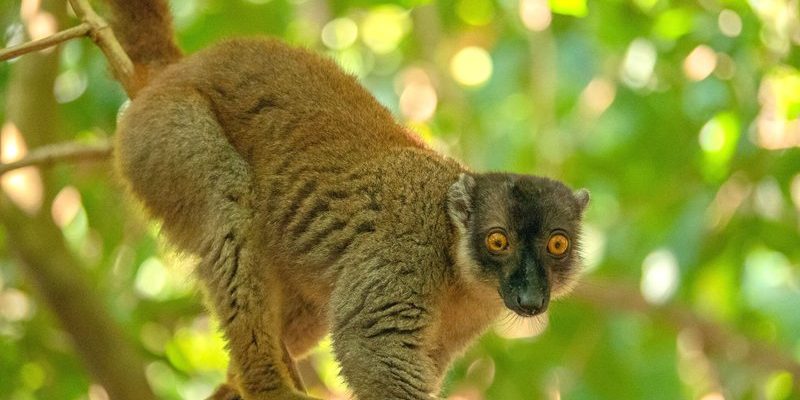
Picture a playful, furry creature swinging through the lush green canopies of Madagascar. That’s the Brown Lemur, a lively and expressive primate that captures the hearts of anyone who encounters it. These charming animals are known for their social behavior and unique features, making them a fascinating subject for animal lovers and researchers alike. With their adorable faces and engaging antics, Brown Lemurs not only add a splash of life to Madagascar’s ecosystems, but they also play a significant role in the region’s biodiversity.
You might be wondering what makes the Brown Lemur stand out among the many species of lemurs found on the island. For starters, they are one of the most recognizable due to their distinctive brown fur and striking yellow eyes. Their lively personalities and social structures offer a glimpse into the complex world of primates. Understanding these incredible animals can deepen your appreciation for the diverse wildlife that inhabits Madagascar, an island brimming with unique flora and fauna.
Physical Characteristics
The Brown Lemur is a medium-sized primate, typically weighing between 4 to 7 pounds. They have a body length of about 18 to 22 inches, with an additional 24-inch tail that helps them balance as they leap through the treetops. Their fur is typically a rich, dark brown, with lighter shades on their face and underbelly, which can make them blend seamlessly into their forest environment. The large, expressive eyes are a standout feature, enabling them to see well in the dim light of the forest understory.
One of the most interesting aspects of Brown Lemurs is their sexual dimorphism in size and color. Males tend to have darker fur than females, who often possess a more reddish-brown hue. This color distinction helps identify each sex quickly in the wild. Additionally, their long, bushy tails are not just for show; they also serve practical purposes. These tails aid in balance during acrobatic leaps and provide communication signals within groups.
Habitat and Distribution
Brown Lemurs are native to the island of Madagascar and are primarily found in the island’s eastern rainforests. Their preferred habitats are moist, deciduous forests, where they can thrive among the tall trees and abundant leaves. These habitats provide them not just with food, but also necessary shelter from predators. The complexity of their forest home allows them to remain hidden from the prying eyes of potential threats while they go about their daily routines.
As their habitat is specifically the eastern rainforests, they are quite sensitive to changes in their environment. Deforestation and habitat destruction have become significant concerns for the survival of Brown Lemurs. Unfortunately, as more forest land is cleared for agriculture and urbanization, the population of these lemurs faces increasing pressure. Conservation efforts are crucial to preserving their unique habitats and ensuring that future generations can witness the captivating lives of these remarkable creatures.
Diet and Feeding Habits
Brown Lemurs are primarily herbivorous, meaning that they feed mainly on plant material. Their diet consists of fruits, leaves, flowers, and seeds. They have a special knack for finding ripe fruits, thanks to their keen sense of smell. Interestingly, Brown Lemurs are also known to consume nectar, which adds a sweet twist to their diet. Their preferred food will vary depending on the season and availability, showcasing their adaptability in the wild.
These lemurs use their strong, agile limbs to navigate the treetops, where they can reach delicious fruits and tender leaves. They are also known to be social eaters, often feeding in groups. This not only allows them to spot potential dangers but also fosters their strong social bonds. Watching them share food and groom each other is a beautiful reminder of the importance of community in the animal kingdom.
Behavior and Social Structure
Brown Lemurs are highly social animals that live in groups called troops, typically consisting of 4 to 15 individuals. The social structure within these troops can be quite intriguing. Female Brown Lemurs usually dominate social hierarchies, and they often lead the group in decision-making processes. This matriarchal system plays a vital role in the troop’s operations, from foraging for food to finding shelter at night.
Communication is essential for Brown Lemurs, and they employ a variety of vocalizations, facial expressions, and body language to express themselves. Their sounds can range from soft grunts to loud calls, alerting others to nearby dangers or signaling the presence of food. The interplay of vocalizations and physical gestures makes their social interactions rich and dynamic.
Reproduction and Lifespan
The breeding season for Brown Lemurs occurs during the rainy months, typically from October to December. After a gestation period of about 120 days, a female usually gives birth to one or two infants. These babies are born relatively helpless and rely heavily on their mothers for survival during the first few months of life. The mother will carry them on her belly or back, allowing them to cling onto her fur as she moves through the trees.
As Brown Lemur infants grow, they begin to explore their surroundings and learn vital survival skills. They are usually weaned by the age of 6 months, but they will remain with their mother’s troop for up to three years as they develop their social skills and learn to forage for food. In the wild, Brown Lemurs can live for about 20 years, although some may reach up to 25 years in captivity. Their lifespan can be influenced by their environment, food availability, and predation.
| Feature | Details |
|---|---|
| Size | 18-22 inches in body length, 24-inch tail |
| Weight | 4-7 pounds |
| Habitat | Eastern rainforests of Madagascar |
| Diet | Fruits, leaves, flowers, seeds, and nectar |
| Social Structure | Troops of 4-15, matriarchal |
| Lifespan | 20-25 years |
Conservation Status
The Brown Lemur is currently classified as endangered by the International Union for Conservation of Nature (IUCN). The primary threats to their survival include habitat loss due to deforestation, hunting, and the illegal pet trade. As the forests of Madagascar continue to shrink, the remaining populations of Brown Lemurs are becoming more fragmented, making it increasingly challenging for them to thrive.
Conservation efforts aimed at protecting Brown Lemurs have gained momentum over the past few years. Various organizations work tirelessly to promote habitat preservation, create protected areas, and educate local communities about the importance of these incredible primates. By raising awareness and supporting conservation initiatives, we can all contribute to the survival of the Brown Lemur and help preserve Madagascar’s unique biodiversity for future generations.
Interesting Facts
If you’re intrigued by the Brown Lemur, here are a few fun facts that might surprise you:
- Brown Lemurs have been known to leap up to 30 feet between branches!
- Their social behaviors include grooming one another, which strengthens bonds within the troop.
- These lemurs have a unique way of waking up; they often sunbathe in the morning before starting their day.
- Brown Lemurs are highly adaptable and can adjust their diet based on seasonal availability of food.
- They play a significant role in forest ecology by dispersing seeds from the fruits they consume.
FAQ
What is the main threat to the Brown Lemur’s survival?
The primary threat to the Brown Lemur is habitat destruction. As Madagascar continues to face deforestation for agriculture and logging, the natural habitats of these lemurs are rapidly disappearing. This loss of habitat threatens their ability to find food, shelter, and mates. Additionally, hunting and the illegal pet trade further exacerbate their plight, making conservation efforts all the more critical.
How does the Brown Lemur communicate?
Brown Lemurs communicate with each other using a combination of vocalizations, facial expressions, and body language. They produce various sounds, including grunts and alarm calls, to convey messages about food sources or potential predators. Their ability to express themselves through different forms of communication is vital for maintaining social bonds within their troops.
Are Brown Lemurs nocturnal or diurnal?
Brown Lemurs are primarily diurnal, meaning they are active during the day. They spend their mornings foraging for food and socializing before resting in the afternoon heat. This behavior allows them to take advantage of the rich resources available in their forest habitats while avoiding nighttime predators.
Can Brown Lemurs be kept as pets?
While the idea of having a Brown Lemur as a pet might sound appealing, it is not advisable. These animals have complex social needs and require specific environments that mimic their natural habitats. Additionally, keeping them as pets can contribute to the decline of wild populations, as illegal trapping and trade often target these exotic animals. It’s essential to appreciate Brown Lemurs in their natural settings or through reputable wildlife sanctuaries.
How do Brown Lemurs help the environment?
Brown Lemurs play a crucial role in their ecosystems by aiding in seed dispersal. As they consume fruits, they inadvertently transport seeds throughout their habitats, promoting plant growth and contributing to forest regeneration. This natural process helps maintain the delicate balance of their environment, benefiting numerous other species that rely on healthy forests.
What are the differences between male and female Brown Lemurs?
Male and female Brown Lemurs exhibit slight differences in size and coloration. Males are generally larger and possess darker fur compared to females, who often have a more reddish-brown hue. This differentiation is not only visually striking but also reflects their distinct roles within the social structure of their troops.
What do Brown Lemurs do during the day?
During the day, Brown Lemurs engage in various activities. They spend considerable time foraging for food, grooming fellow troop members, and socializing. Morning sunbathing is also common, as they soak up the warm rays before embarking on their daily adventures. Their active and social nature makes them a delight to watch in the wild.
Are Brown Lemurs endangered?
Yes, the Brown Lemur is classified as endangered due to habitat loss, hunting, and the illegal pet trade. Conservation efforts are underway to protect their remaining populations and habitats, but continued dedication is necessary to ensure their survival. Supporting these initiatives can help safeguard the future of Brown Lemurs and promote biodiversity in Madagascar.
How long do Brown Lemurs live in the wild?
Brown Lemurs can live around 20 years in the wild, although some individuals may reach up to 25 years in captivity. Their lifespan can be influenced by various factors, including environmental conditions, availability of food, and predation risks. Providing a safe habitat is crucial for their longevity in the wild.
What is the role of Brown Lemurs in their social groups?
In their social groups, Brown Lemurs play significant roles that contribute to the well-being of the troop. Females typically lead the group and make decisions regarding foraging and safety. Social interactions, such as grooming, help strengthen bonds and reinforce the hierarchy, ensuring a cohesive and functioning troop dynamic.

